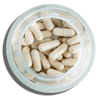The extracellular matrix (ECM) is the skin's structural framework, responsible for firmness, elasticity, and overall skin health. As we age, both internal factors (like genetics and hormones) and external factors (like UV exposure and pollution) contribute to its breakdown. This leads to visible aging signs such as wrinkles, sagging, and dryness. Key processes driving ECM degradation include reduced collagen and elastin production, oxidative stress, and increased enzyme activity (like MMPs breaking down proteins).
To support ECM health:
- Diet: Eat foods rich in antioxidants and anti-inflammatory compounds.
- Lifestyle: Stay hydrated, exercise, and avoid smoking or excessive alcohol.
- Supplements: Ingredients like NMN, Resveratrol, Fisetin, and Spermidine can help restore ECM integrity.
- Protection: Use sunscreen to reduce UV damage.
#10 - Dr. Collin Ewald | Collagen Protein & Extracellular Matrix During Aging
Collagen and Elastin: Core Skin Proteins
When changes occur in the extracellular matrix (ECM), the breakdown of its essential proteins - collagen and elastin - becomes a major factor in visible skin aging. These proteins play a crucial role in maintaining the skin's firmness and elasticity.
Collagen: Structure and Age-Related Changes
Collagen makes up a staggering 70–80% of the skin's dry weight, serving as its primary structural framework [4]. However, as we age, collagen production slows down significantly - starting around age 30 [5]. In fact, collagen synthesis decreases by about 1–1.5% every year [8]. Beyond producing less collagen, the aging process also causes it to fragment [6]. Compounding this issue, fibroblasts - the cells responsible for creating collagen - reduce in both number and efficiency over time. This decline weakens the skin's structure, leading to wrinkles and sagging [4]. These changes highlight the ECM's critical role in skin aging.
Elastin: Maintaining Skin Flexibility
Although elastin accounts for only 2–4% of the ECM, it’s vital for skin elasticity [4]. Elastin allows the skin to stretch - like when you smile or frown - and then return to its original shape [3][5]. It works alongside microfibrils to form elastic fibers, giving the skin its bounce and resilience. Unlike many other proteins that are regularly replenished, elastin has an incredibly long lifespan, often lasting throughout a person’s life. Unfortunately, this means that damage to elastin accumulates over time. Processes such as crosslinking and chemical modifications degrade and fragment elastin [3], reducing the skin's ability to snap back into place. This results in a looser, sagging appearance [5][7].
Simple lifestyle choices can help protect these vital proteins. A diet rich in protein, regular exercise, staying hydrated, and protecting your skin from the sun are all effective ways to support collagen and elastin [5].
How ECM Breaks Down in Aging Skin
The deterioration of the extracellular matrix (ECM) in aging skin is a complex process tied to both internal cellular shifts and external environmental damage. Research shows that skin aging involves an imbalance between the creation and breakdown of ECM molecules, leading to structural changes that impact the skin's appearance over time [10]. This imbalance sets off a chain reaction, altering the skin's firmness and elasticity through enzymatic and oxidative mechanisms.
Matrix Metalloproteinases (MMPs) and Protein Breakdown
Matrix metalloproteinases (MMPs) are enzymes that act like molecular scissors, breaking down key ECM proteins responsible for maintaining skin's firmness and elasticity. While MMPs are essential for processes like wound healing and tissue repair, their heightened activity accelerates skin aging [10].
The breakdown of ECM involves multiple enzymes working together. Besides MMPs, enzymes such as plasmin and cathepsins also contribute to dismantling the ECM's structural components [10]. Specific MMPs target particular proteins: MMP-1, MMP-3, and MMP-10 are especially active in degrading collagen, while others focus on elastin. Over time, this increased enzymatic activity weakens the ECM.
Environmental factors, particularly UV radiation, amplify the activity of these enzymes. UVB rays (280–320 nm) are especially effective at inducing MMP-1, MMP-3, and MMP-10, while UVA1 rays (340–400 nm) have a less pronounced effect [10]. Additionally, UVB exposure increases the activity of neutral endopeptidase (NEP), a metalloprotease that disrupts elastin's structure, further diminishing skin elasticity [10].
Oxidative Stress and Inflammation Effects
Oxidative stress also plays a major role in ECM breakdown by creating a harmful environment for its proteins. UV radiation generates reactive oxygen species (ROS) in the skin, which damage cellular components and weaken ECM integrity. UV light is considered the leading cause of photoaging, responsible for about 90% of visible skin changes [10][12]. These ROS activate MAPK proteins, which in turn stimulate further MMP production, accelerating ECM degradation.
Prolonged UV exposure not only damages the ECM but also reduces the skin's ability to repair itself. For instance, studies show that UVA exposure decreases the expression of collagen and proteoglycan genes, resulting in lower production of these vital ECM components [10]. This decline in regenerative capacity contributes to visible signs of aging, such as wrinkles, rough texture, and uneven pigmentation.
Chronic inflammation adds another layer of damage. Persistent inflammatory states sustain high levels of destructive enzymes and continuously harm both cells and the ECM [11]. This creates a damaging cycle where the skin's natural repair mechanisms are overwhelmed, speeding up the aging process and amplifying the visible effects of aging.
sbb-itb-4f17e23
Recent Research on ECM and Skin Aging
Expanding our understanding of ECM breakdown, recent studies have introduced advanced tools to delve deeper into the aging process. These breakthroughs not only shed light on key mechanisms but also pave the way for potential treatments.
New Tools for Studying ECM
Cutting-edge tools are transforming how researchers study the extracellular matrix (ECM):
- Organoids: These lab-grown skin models replicate human skin structure more effectively than traditional 2D cultures or animal models, providing a more realistic environment for research [13].
- Microfluidic Platforms: Known as organ-on-a-chip models, these systems allow precise control over cell and molecule distribution, enabling researchers to create multilayered skin models that closely resemble human tissue [14].
- Advanced Imaging Techniques: Super-resolution and light sheet microscopy, imaging mass cytometry, and X-ray scattering offer detailed insights into ECM's molecular organization [17]. Biophotonics methods like Raman spectroscopy are particularly useful for detecting biomechanical changes, such as increased glycosaminoglycans contributing to tissue stiffness [18].
Key Research Findings on ECM Aging
Recent discoveries highlight how ECM changes with age and the factors driving these shifts:
- Collagen Turnover: Type I collagen, which makes up 80–85% of the dermal ECM, is replaced every 30 years in youth. However, this process slows significantly with age, contributing to visible signs of aging [15].
- Matrix Metalloproteinases (MMPs): These enzymes play a pivotal role in skin aging. Research by Quan et al. revealed that elevated MMP-1 activity in fibroblasts leads to collagen fibril fragmentation, disrupting fibroblast-ECM interactions and impairing collagen balance, which accelerates dermal aging [16]. Additionally, UV exposure triggers a cascade involving CRAT downregulation and activation of ERK, JNK, and p38 MAPK pathways, further increasing MMP-1 levels and ECM degradation [16].
- Natural Compounds: Promising research has identified protective agents against ECM breakdown. For example, Asharaf et al. demonstrated that sulfated mannogalactan (BVP-2) from Bacillus velezensis reduces MMP-1, MMP-2, and MMP-9 expression while minimizing oxidative stress [16]. Similarly, Novotná et al. found that compounds like rhamnose, rutinose, hesperidin, and hesperetin not only lower MMP-1 and MMP-2 levels but also enhance collagen I production in some cases [16].
- Emerging Technologies: AI and machine learning are being used to analyze complex ECM datasets, uncovering patterns that could inspire new anti-aging treatments [13][17]. Meanwhile, mass spectrometry proteomics is helping researchers map changes in tissue composition during aging, with efforts underway to create a comprehensive multi-omic atlas of ECM aging [17]. Extracellular vesicles (EVs), which play a key signaling role in ECM health, are also gaining attention as potential therapeutic targets [17].
Practical Applications and Industry Impact
These technological advancements are addressing significant challenges in skin research. Skin diseases are a major global concern, ranking as the 18th leading cause of disease burden and the fourth leading cause of disability worldwide [14]. Traditional preclinical drug testing in rodents can cost $2–4 million per candidate drug [14], making human-relevant models like organoids particularly valuable. The cosmetic and skincare industries are increasingly adopting these models to develop and test products aimed at preserving ECM integrity and combating signs of aging [13].
Supporting Skin and ECM Health
As we age, the breakdown of the extracellular matrix (ECM) becomes more apparent, highlighting opportunities to address its root causes and encourage natural repair processes. By understanding these intervention points, we can better preserve skin health.
Approaches to ECM Support
Maintaining ECM health involves tackling oxidative stress, inflammation, and reduced collagen production.
A diet rich in antioxidants - found in fruits, vegetables, spices, and herbs - helps combat free radical damage. Meanwhile, anti-inflammatory foods like turmeric, green tea, ginger, garlic, and onion can lower matrix metalloproteinase (MMP) activity, which contributes to ECM degradation. Additionally, keeping a low glycemic load in your diet reduces advanced glycation end-products (AGEs) that cross-link with collagen, further protecting the ECM.
Research supports the benefits of oral collagen supplementation. Randomized controlled trials have shown improvements in skin hydration, elasticity, and moisture. For instance, one study reported notable increases in skin hydration and elasticity after 12 weeks of supplementation [9]. Collagen peptides provide key amino acids - proline, glycine, and hydroxyproline - that enhance fibroblast activity, leading to the production of new collagen, elastin, and hyaluronic acid [9][21].
Lifestyle choices also play a critical role. Staying hydrated (aiming for more than 2 liters, or about 0.5 gallons, of water daily), exercising regularly, getting enough sleep, and fostering positive social connections all contribute to ECM health. On the flip side, avoiding smoking, excessive alcohol consumption, and high-fat diets can protect ECM integrity. Beyond diet and lifestyle, supplements backed by scientific research offer an additional layer of support.
How MASI Longevity Science Supports Skin Health

In addition to dietary and lifestyle measures, MASI Longevity Science offers targeted supplementation to support ECM integrity. Their approach focuses on addressing the underlying causes of aging with premium formulations that include NMN, Resveratrol, Fisetin, and Spermidine. These ingredients are designed to work together to combat cellular processes that lead to ECM breakdown and skin aging.
- NMN (Nicotinamide Mononucleotide): This compound supports energy production at the cellular level and aids in DNA repair, which is essential for maintaining healthy fibroblasts - the cells responsible for producing collagen and other ECM components. Since NAD⁺ levels naturally decline with age, NMN supplementation can help restore energy metabolism and bolster the body's repair mechanisms.
- Resveratrol: Known for its powerful antioxidant properties, Resveratrol neutralizes free radicals that can damage collagen and elastin fibers. It also helps regulate inflammatory responses, reducing excessive MMP activity.
- Fisetin: Acting as a senolytic, Fisetin helps clear out senescent cells, which accumulate in aging skin and contribute to chronic inflammation and ECM degradation. Removing these dysfunctional cells creates a more favorable environment for ECM repair.
- Spermidine: This ingredient promotes autophagy, a cellular cleanup process that removes damaged proteins and organelles. By supporting fibroblast function, Spermidine aids in the production of high-quality collagen and other ECM components.
MASI's supplements are crafted in Germany and undergo independent testing in Switzerland to ensure purity and efficacy. The recommended dosage is one capsule daily for individuals aged 40–50, and two capsules for those over 50 [19]. These products are vegan-friendly and free from GMOs, soy, lactose, gluten, and common allergens, making them suitable for a wide range of dietary preferences.
With over 352,000 individuals relying on MASI Longevity Science [20], their carefully designed supplements provide targeted support to help maintain ECM health and promote healthier skin as we age.
Conclusion: ECM's Role in Skin Aging
The extracellular matrix (ECM) serves as the skin's structural framework, playing a key role in maintaining tissue integrity and enabling cellular communication through its intricate network of proteins, enzymes, and glycosaminoglycans like hyaluronic acid.
As we age, the breakdown of collagen and elastin weakens the skin's structure. Compounding this, age-related crosslinking of elastin contributes to wrinkles and a loss of firmness [1][22].
This process creates a vicious cycle: senescent cells release matrix metalloproteinases, which further degrade collagen and elastin. At the same time, the stiffening of the ECM triggers fibrotic feedback loops, altering cell function and accelerating skin aging [2].
To address these challenges, targeted solutions are emerging. MASI Longevity Science offers supplements designed to support ECM health. These include NMN for boosting cellular energy, Resveratrol for antioxidant defense, Fisetin to help clear senescent cells, and Spermidine to encourage autophagy. Together, these ingredients aim to restore ECM integrity and enhance skin vitality.
Protecting the ECM means addressing aging at its root rather than just treating surface-level effects. By supporting fibroblast activity, we can help maintain the skin's structural foundation, promoting a youthful appearance and feel as we navigate the aging process.
FAQs
How do diet and lifestyle choices affect the extracellular matrix and help slow skin aging?
Your diet and daily habits have a huge impact on the health of your extracellular matrix (ECM) - the foundation for firm, youthful skin. Eating a diet rich in antioxidants, vitamins, and minerals helps support collagen and elastin production while reducing oxidative stress, both of which are critical for keeping the ECM strong and slowing down skin aging. On the flip side, consuming too much sugar or unhealthy fats can trigger inflammation and speed up collagen breakdown, which can lead to premature wrinkles and sagging.
Adding foods like berries, leafy greens, nuts, and fatty fish to your meals can strengthen your skin’s antioxidant defenses and encourage cell renewal. Staying hydrated, limiting sun exposure, and managing stress are also key to protecting the ECM and keeping your skin looking younger for longer. Even small, consistent tweaks to your routine can have a lasting impact on your skin’s health.
How do supplements like NMN, Resveratrol, Fisetin, and Spermidine support skin health and the extracellular matrix?
Supplements like NMN, Resveratrol, Fisetin, and Spermidine are known to support the extracellular matrix (ECM), which is crucial for keeping the skin firm and elastic. These compounds work to combat oxidative stress and promote cellular health, both of which are key to slowing the breakdown of the ECM - a common factor in skin aging.
Take Resveratrol and Fisetin, for instance. These compounds are known to boost mitochondrial function and reduce inflammation, helping to protect vital ECM components such as collagen and elastin. Similarly, Spermidine plays an important role in maintaining mitochondrial health and has anti-inflammatory properties, which contribute to cellular renewal and help preserve the ECM. By slowing the degradation of essential ECM proteins, these supplements work together to support a stronger, more youthful skin structure.
What recent advancements in studying the extracellular matrix are helping to develop better anti-aging treatments?
Recent progress in extracellular matrix (ECM) research is reshaping how anti-aging treatments are developed. For instance, bioengineered hydrogels - designed to replicate natural ECM components like collagen - are being used to aid tissue regeneration and improve skin elasticity. These developments work to restore the ECM’s structure, leading to healthier and more youthful-looking skin.
On top of that, advanced imaging and molecular diagnostic tools now make it possible for researchers to identify specific ECM-related aging processes with precision. This allows for the creation of treatments that directly target these processes, boosting cellular renewal and strengthening skin resilience. These efforts reflect MASI Longevity Science’s dedication to using the latest research to enhance skin health and overall well-being.




